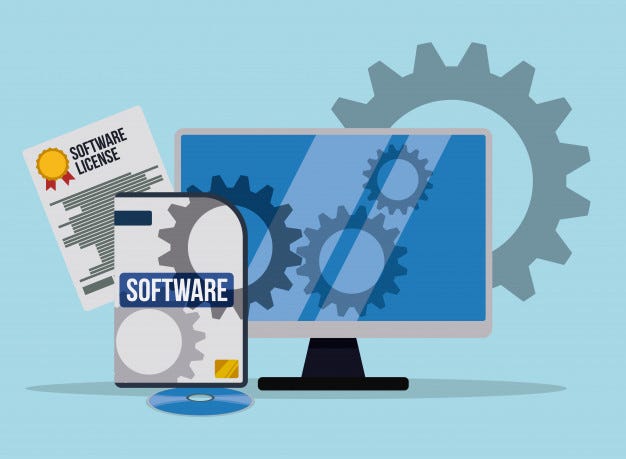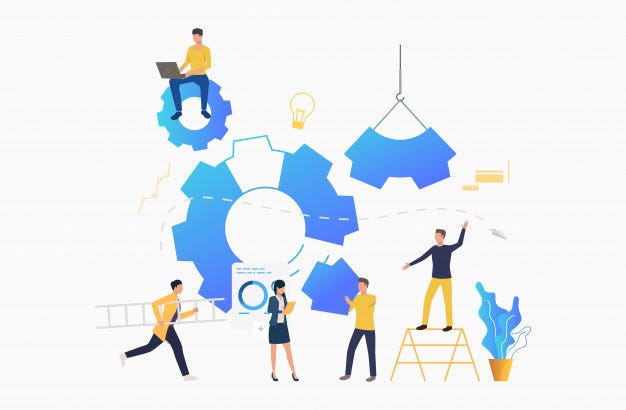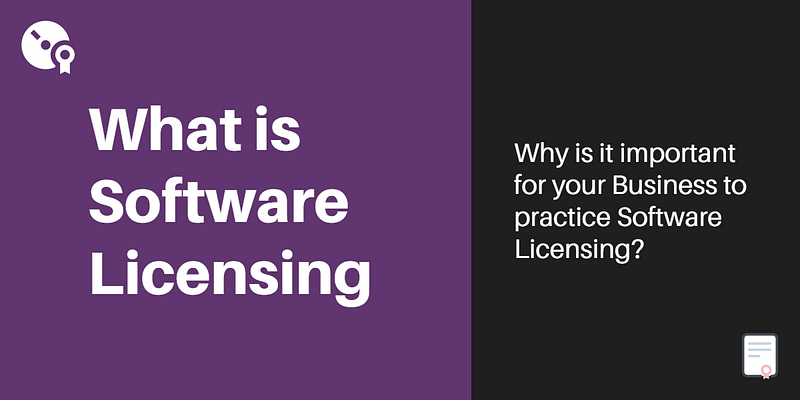Software licensing — what does your organization need to know?
Organizations deploy sophisticated IT software to provide backup support for critical business information. To avoid unwanted breakdowns, companies should ensure a reliable IT software base. One way to do this is to exercise a streamlined management routine for software management. Basically, when choosing a software, a company needs to focus on three main aspects; the size of the business, the company’s specific needs, and the tasks involved that require automation.
Listing down such information helps to filter out options. After doing this, institutions can choose from three different types of software applications:
- System software: This enables companies to effectively coordinate the activities and functions of hardware and installed programs.
- Application software: Mainly used for the purpose of completing tasks while using hardware devices. Common examples include word processor programs and spreadsheets.
- Proprietary software: Usually the type with restrictions on copying and modifying content from the manufacturer. For example, antivirus software.
One important thing to consider when installing software for your company is its license. The majority of firms have limited knowledge about software licenses and this often results in heavy penalties. In general terms, a license is an agreement between the owner and the company (user). Under the terms and conditions laid down by this contract, users can utilize the software as required which otherwise would’ve been considered an infringement of law.
A valid license lets you answer questions like:
- Where and how frequently can you install the program?
- Is it allowed to be copied, modified or redistributed?
- Can you access the underlying access code?
- What are the common types of software licenses?
It is quite common for companies to purchase various types of software licenses to run daily functions. Each type is suited to a specific organizational structure which caters to users and their requirements. Before deploying a software, corporations should learn about the features different software licenses can offer:
Individual license: Typically, this sort of license allows the program to be installed on one computer and cannot be accessed by others over a network. So, ideally, such a license is suitable for executive tasks which limit unauthorized access. Some examples of individual licenses are:
- Perpetual license: It can be installed by the customer for indefinite use with technical support for up to 90 days.
- Subscription license: For this, the time period is usually specified and usually includes technical support and easy access to upgrades released during the time of subscription. At the end of the term, users can apply for renewal or purchase a perpetual license at a discount or uninstall the software.
- Shareware license: Generally, this is a license to use certain software for a trial period after which shareware fee has to be paid.
Individual/Multi-user license: Under this comes the following:
- Volume license: Can be used to install the software on a number of computers. However, there is a minimum purchase requirement which needs to be satisfied which qualifies the licensee for a discount.
- Site/enterprise license: Using such a license allows access to the software at a specified location. This type of license is obtained on user request and vary widely in their provision.
Network/Multi-user license: The following examples come under this license:
- Server: As it is licensed per server, this type requires you to have a single copy of the software installed on the server. With this license, there is a set number of users associated with a particular server. Simultaneously, the number of devices which can use this license is also limited for a single server.
- Per machine: License purchased for each client computer and device fall under this category. This license is mainly used in combination with a network license.
- Per processor: Slightly different from other models, this type of license has an unlimited number of users. A processor license has to be deployed on each processor in the server on which the software is running.
While organizations have a variety of options to choose from, all licenses offer add-on services. Some common ones include upgrades in which firms can switch from an older version to a newer one. However, this is not the same as a subscription or a maintenance license and the company can no longer use the previous version once upgraded.
In contrast to the above, subscription/maintenance is purchased in addition to the software license and validates all updates during the term of the contract.
What is software license compliance and why is it important?
Upon acquiring the right type of software, the next step is to ensure compliance with legal regulations. Having a viable software license mitigates chances of misuse and infringement of intellectual property. It, therefore, becomes extremely vital for licensee organizations to incorporate proper controls in place to oversee the utilization of software assets. This practice is termed as software license compliance.

To attain compliance, companies can start by keeping a comprehensive inventory of all software installed on the network and compare this against what they are legally entitled to be using. This is only possible if you have all related purchase documentation as proof of the license. Such information comes in extremely handy as it enables organizations to pass audits.
Due to the complex nature of tasks, IT managers often struggle with real-time visibility which leads to non-compliance. According to BSA Global Software Survey, 37% of the software installed on computers around the world are not properly licensed. To tackle this issue, it is critical to understand what causes non-compliance:
- License overuse: Not only limited to deployment, but overuse of a license can also result from a lack of accounting or usage outside the terms and conditions mentioned in the license agreement. Furthermore, unprecedented sharing of user accounts, concurrent use, cross-border use, unsupervised virtualization and access to third-party applications is also labeled as overuse.
- Complex software license contracts: The terms and conditions laid down in a license agreement can be vague and require attention at the time of negotiation as well as implementation. Such contracts need proper interpretation for compliance with license usage. Failure to understand the agreement can cause confusion which may ultimately pose financial risks to the organization.
- Inadequate user roles: Most of the times, users are granted access based on the roles they perform in the organization. They are also licensed according to the roles dictated on the system. All users licensed under the highest category may result in a loss in revenue for the company. Therefore, it becomes vital to control and regulate user roles to maintain compliance with the license terms.
- License restrictions: Sometimes, software publishers sell licenses in a bundle. A few of them can be broken into individual components to be used as regular products while others have limited usage restrictions. Non-compliance with such regulations can lead to termination of software or penalties. To control for such actions, it is critical to monitor software deployment as well as utilization.
Gartner expects worldwide spending on IT assets to reach $3.8 trillion in 2019, a 3.2 percent increase from the previous year. This change suggests that organizations invest a significant portion of the budget in IT assets. Following this trend, companies without a robust software asset management strategy are prone to risks which can impact their credibility as well as the bottom line.
Failure to complete software audits results in non-compliance. The majority of institutions don’t realize how often audits happen and whether the firm is in violation of the software agreement. Substandard management policies may incur hefty fines for non-compliance. In addition to this, companies tend to waste money on software which isn’t actually needed. The lack of a centralized system leads different departments to procure the same type of software. An overlap within the organization means many software go unused and unlicensed.
Gaining software license compliance in ten simple steps!
In order to effectively allocate resources and optimize utilization, it is essential to lay down a basic user guideline. Similarly, for IT software assets, companies should establish some fundamental management strategies. Doing so helps improve performance and maximize the rate of returns.

Here are ten easy steps to practice software licensing the correct way:
A. Develop a central system: Start off by directing all software purchases through a central procurement or the IT department. Doing so will help simplify tasks and let you control software installation. Having accurate records enables you to discontinue unused or outdated software assets. In addition to this, all license information is stored at a single platform which validates software purchase through proper channels.
B. Establish a support team: The next stage involves laying down a mechanism to facilitate software requests by different departments. Organizations should establish a strong support team which is capable of providing a prompt response to procurement orders. Such practices eliminate the chances of staff members and managers acquiring software from unregistered vendors.
C. Choose authorized sellers: Opting for a software seller, one that is authorized by the manufacturing company ensures that the product is genuine. This helps in getting a valid software license which is recognized by the developer. Majority of software companies provide a list of reliable resellers on their websites as well.
D. Gather accurate data: At times, unforeseen circumstances can cause companies to get penalized for copyright infringement or asked for an audit by a software producer. If so, how does an organization respond? The first thing to do is to gather all detailed records about your software assets. There are two main software industry associations; Business Software Alliance and the Software & Information Industry Association. These institutions require a comprehensive list of software installations and proof of licenses during an audit. A cloud-based system lets you retain accurate information which enables you to verify acquired software programs.
E. Conduct self-audits: An online IT asset management system can help companies run reports on all copies of the software installed on servers. You can sign up for routine inspections through the software as well. Such practices eliminate chances of infringement and ensure license compliance at all times.
F. Issue strict policies: When it comes to IT asset usage, it is important to educate the company employees as well. This can be done by including the following policies in the employee manual:
- It is the organization’s policy to use only licensed software and comply with all the terms and conditions of the agreement.
- All those attempting to download unauthorized/unlicensed software copies will be subject to disciplinary action by the company which may result in criminal liability.
- A detailed guide to the proper procedure for requesting the installation of software on any computer.
G. Upgrade in the correct way: At times when a particular software is updated, data on older versions may be unintentionally left on the computers. This is problematic because any copy be it the previous version of the same software requires a separate license. So, to avoid non-compliance, companies should delete all older software versions after recommended upgrades.
H. Monitor the trial phase: Any software programs which are installed for a trial period should be removed from the servers immediately after the testing time expires.
I. Control user access: The majority of companies struggle with unlicensed software copies or unauthorized downloads. One solution to this issue is to lock down all computers to require administrative passwords to install any software. This lowers the chances of unlicensed software being deployed in the organization.
J. Train IT managers: Software license management policies get updated regularly. For this reason, a good practice is to train IT managers through established programs.
Conclusion
Software licensing involves various different stages starting off from procurement, deployment, lifecycle management and eventually disposal. Organizations often opt for a cloud-based IT asset management program to gather accurate information to conduct self-audits. An updated software database enables companies to remain prepared to defend themselves in cases of non-compliance. A strong business team adopts a proactive approach to software licensing by tracking usage at all times.
By choosing authorized vendors and having a sound understanding of the license agreements, companies can practice efficient software licensing. Forecast software growth and develop an effective purchase plan for your organization. Staying license compliant improves performance and provides real-time visibility into the business progress rate.
About AssetSonar
AssetSonar is the leading software compliance tool that offers comprehensive software license tracking. It enables companies to ensure license compliance, optimize software spend, and become audit-ready. Sign up for your 15-day trial today!







